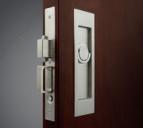How to detect deadbolt?
I want to make a way to remotely find out if the deadbolt was locked or not. On a pocket door, a deadbolt comes out of the door edge and has some flaps that go up and down inside a receiver box to secure the door. I want to be able to check if it was locked or not. Adding a magnet to the leading edge of the deadbolt for hall sensing would not look great and it might get knocked off.
https://www.parallax.com/product/555-27401
I thought about putting this inside the receiver box that sits in the jamb, so that if the deadbolt is pushed in, the sensor would detected it, however the problem is that the deadbolt with either be about .25" away if locked and 1.25" away if not locked. I am not sure how this sensor would work at such a small range of distance. I don't want to put a spring loaded switch if possible.
Any suggestions?
I tested a 38k modulated LED on one side of the box, and a 38k detector on the other side, and when the deadbolt is inserted it blocks the light. It adds some bulk on either side of the receiver box, and also over time may die and will be difficult to get access to it. Also, I am thinking the light may reflect and get around the deadbolt.
In the drawing, #20 is the receiver box that is a very thin metal, easily drilled.
https://www.parallax.com/product/555-27401
I thought about putting this inside the receiver box that sits in the jamb, so that if the deadbolt is pushed in, the sensor would detected it, however the problem is that the deadbolt with either be about .25" away if locked and 1.25" away if not locked. I am not sure how this sensor would work at such a small range of distance. I don't want to put a spring loaded switch if possible.
Any suggestions?
I tested a 38k modulated LED on one side of the box, and a 38k detector on the other side, and when the deadbolt is inserted it blocks the light. It adds some bulk on either side of the receiver box, and also over time may die and will be difficult to get access to it. Also, I am thinking the light may reflect and get around the deadbolt.
In the drawing, #20 is the receiver box that is a very thin metal, easily drilled.




Comments
Proximity Sensors LDC0851 Differentially Compensated and Highly Accurate Inductive Switch
http://www.mouser.com/ProductDetail/Texas-Instruments/LDC0851HDSGR/?qs=sGAEpiMZZMs3uAJYYmvlK0y75LftYGld%2baD8v0dfs43ogAWcyHIXSg==
Seairth, the deadbolt does not really make contact with 19 and 20.
1: Looking at the deadbolt head on, side by side coils with reference metal plate or stacked coils on 4 layer pcb board.
2: Make bolt slide sideways over two side-by-side coils (probably best if you want it inside door and not frame)
You tune the RED coils so it wins if both coils is seeing the dead bolt.
Green coil wins when 50% of the red coil is not seeing the bolt
I have a deadbolt viewing situation also.
I resolved it by setting up a camera to watch my front door.
I can see if it is locked and I can also see if the door is ajar.
This is a very different method than you are thinking about, but I
thought I'd throw this in there because it works for me.
I use Insteon hub and camera.
You said the deadbolt does not make contact with the receiver box. Change that. just cut the spring of a ball pen in half pull both longer, mount both insulated in the receiver and then let the deadbolt make a contact between both. Or any other form of simple switch.
Maybe a piece of soft foam and two contacts to be connected by the deadbolt?
Enjoy!
Mike
So you want to sense the final locking state of 'flaps out', not just 'bolt in' ?
Sounds tough.
A small reflective sensor, something like
http://www.sharpsma.com/webfm_send/1267
with two holes in the back of the box that 'looked' at the flaps, may work.
You would adjust the LED drive & sync-detect, to get the levels right.
Are the flaps magnetic, or stainless ?
-Phil
Sometimes these sensors are needed to prove a door is both locked and dead-bolted.
eg A common attack is simple clear tape over the door latch, so the door appears to be closed and locked, but actually is not.
The felons come back later, and simply walk in their pre-prepared door.
Actual sense of the dead-latch flaps, give better assurance.
If the deadbolt is in, then the flaps must be out too, they pop out at the last bit of travel of the deadbolt. I can't put springs to hold the door open and there cannot be any additional force required to push the deadbolt into the receiver(springs, plungers etc). However, I like the idea of making the flaps become part of a switch. I can make my own receiver with isolated top and bottom parts that are spring loaded so that when the flaps extend up and down, they make contact with metal surfaces and complete a circuit.
On my next batch of PCB orders I will definitely add that circuit Tony mentioned, that would be very useful for other experiments.